SAP p-sapea-2023 practice test
SAP Certified Professional - SAP Enterprise Architect
Question 1
As the Chief Enterprise Architect of your company you have been asked by the CIO to apply agile
principles instead of following the sequential phases of TOGAFS ADM. How do you respond?
- A. The SAP EA Framework combines the sequential approach of the TOGAF® ADM with agile principles Agile principles are included and can be applied only to Application Architecture. Therefore, the SAP EA Framework is especially suitable for organizations that follow agile principles.
- B. It is reasonable to apply an agile methodology for the most urgent tasks and switch to the process as guided by the SAP EA Framework later, as long as the fundamental IT architecture is not affected Collecting "low-hanging fruit, and realizing instant value before using the SAP EA Framework, and ensuring an overall successful transformation is possible.
- C. It is essential to fully understand the business needs and to successfully review the business architecture with critical stakeholders before going to the next phase. In the implementation phase, agile approaches can naturally provide quick wins, constant progress, and the benefit of early validation. The phased approach, during architecture definition phases, avoids double work and will lead to overall better results.
- D. The TOGAF® ADM already embraces agile principles within and across phases and generally follows a cyclic approach. The SAP EA Framework builds on that and is especially suitable for organizations that follow agile principles.
Answer:
D
Explanation:
In the context of incorporating agile principles into the TOGAF's Architecture Development Method
(ADM), Option D is accurate. The TOGAF® ADM is inherently iterative and dynamic, which means
that it doesn't strictly have to be a linear process. It allows for feedback at any stage of the
development cycle and can be adapted to include agile practices. The SAP Enterprise Architecture
(EA) Framework is built to be flexible and can incorporate agile principles, supporting rapid iterations
and adaptive planning. The agile approach is integrated into the SAP EA Framework to enhance
responsiveness and to enable a continuous delivery model that aligns with the iterative nature of the
ADM. Agile principles can be applied within and across the different phases of the ADM, promoting a
more flexible and responsive architecture development process that is suited for organizations
following agile methodologies.
Reference:
TOGAF documentation outlining the iterative nature of ADM.
SAP EA Framework documentation discussing integration with agile methodologies.
Question 2
When creating an application architecture roadmap, the WHAT and WHERE are defined in a rather
straightforward way, while the WHOM may differ by context. Multiple roadmap clusters may apply a
variety of WHOM dimensions. For example, procurement vs. asset management. Which of the
following definitions are correct? Note. There are 3 correct answers to this question.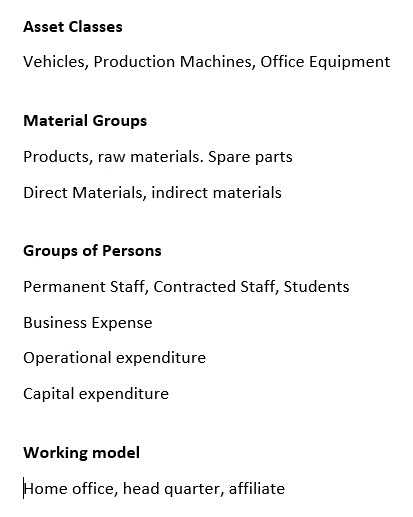
- A. Asset Classes/Vehicles, Production Machines, Office Equipment
- B. Material Groups/Products, raw materials. Spare parts/Direct Materials, indirect materials
- C. Groups of Persons/Permanent Staff, Contracted Staff, Students/Business Expense/Operational expenditure/Capital expenditure
- D. Working model/Home office, head quarter, affiliate
Answer:
BCD
Explanation:
When creating an application architecture roadmap, the ‘WHOM’ dimension refers to the
stakeholders or entities that will be impacted by or interact with the application. This dimension can
vary greatly depending on the context and the specific focus areas of the roadmap. The correct
answers that define the ‘WHOM’ dimension in various contexts are:
B . Material Groups/Products: This refers to the categorization of items such as raw materials, spare
parts, direct materials, and indirect materials. These groups are relevant stakeholders in the context
of procurement and supply chain management applications.
C . Groups of Persons/Business Expense: This includes different categories of personnel such as
permanent staff, contracted staff, and students. It also encompasses different types of expenses like
operational expenditure and capital expenditure, which are crucial considerations for financial
management and human resource management applications.
D . Working model: This pertains to the various operational models such as home office,
headquarters, and affiliates. These models are significant for applications that manage organizational
structures, remote work capabilities, and location-based access to resources.
A . Asset Classes/Vehicles is not a correct answer as it describes types of assets rather than
stakeholders or entities interacting with the application.
Reference:
SAP. (n.d.). SAP Enterprise Architecture Framework. SAP Community.
The Open Group. (2018). TOGAF® Version 9.2: Enterprise Architecture Framework.
International Organization for Standardization. (2015). ISO/IEC/IEEE 42010:2011 - Systems and
software engineering — Architecture description.
Question 3
Green Elk & Company is the world's leading manufacturer of agricultural and forestry machinery. The
former company slogan "Eik always runs has recently been changed to "Eik feeds the world" One of
Green Elk's strategic goals is to increase its revenue in the emerging markets of China, India, and
other parts of Asia by 80 % within three years. This requires a new business model that caters to
significantly smaller farms with limited budgets You are the Chief Enterprise Architect and the
decision was taken to implement regional S/4HANA productive systems while ensuring a high degree
of standardization. Which of the following implementation approach would you consider best in this
case?
- A. Phased by Application
- B. Big Bang
- C. Small buck
- D. Phased by Company
Answer:
A
Explanation:
As the Chief Enterprise Architect for Green Elk & Company, the strategic goal of expanding into
emerging markets with a new business model tailored for smaller farms requires a careful and
considered approach to implementing S/4HANA productive systems. The best implementation
approach in this scenario would be Phased by Application.
This approach allows for a gradual rollout of the S/4HANA system across different applications, which
can be prioritized based on the most critical business needs and the unique requirements of each
regional market. By implementing in phases, the company can ensure that each application is
tailored to support the new business model effectively while maintaining a high degree of
standardization across the regions.
The benefits of a Phased by Application approach include:
Risk Mitigation: By deploying one application at a time, the company can minimize the risks
associated with a large-scale implementation.
Focused Attention: Each phase allows the project team to focus on specific applications, ensuring
better quality and alignment with business needs.
Feedback Incorporation: After each phase, feedback can be gathered and incorporated into
subsequent phases, aligning with agile principles.
Resource Optimization: Resources can be allocated more efficiently, with expertise focused on
specific applications during each phase.
The other options, such as Big Bang, would involve a high-risk, all-at-once implementation, which is
not suitable given the strategic and operational changes required. Small buck is not a recognized
implementation strategy in the context of enterprise architecture. Phased by Company could be
considered if the organizational structure was the primary concern, but given the focus on
application alignment with the new business model, Phased by Application is the most appropriate.
Reference:
SAP SE. (n.d.). Implementing SAP S/4HANA: A Framework for Planning and Executing SAP S/4HANA
Projects. SAP SE.
The Open Group. (2018). TOGAF® Version 9.2: Enterprise Architecture Framework.
SAP SE. (n.d.). SAP Activate Methodology. SAP SE.
Question 4
For the next Architecture Board meeting, you need to determine the next steps required after the
business, application/data and technology architecture designs have been created. What do you
recommend?
- A. Reviewing Business Application/Data and Technology Architecture artifacts with stakeholders and signing off on first versions.Using Transition Architectures to build the Architecture Roadmap. Creating first drafts of the required work packages and the Project/Rollout plan.
- B. Finalizing the Business, Application/Data, and Technology Architecture artifacts. Building an Architecture Roadmap. Creating a first draft of the Project/Rollout Project plan.
- C. Establishing change management processes for the management of the business application/data and technology artifacts Handing over the artifacts to the implementation partner and rolling out the project
Answer:
A
Explanation:
After the business, application/data, and technology architecture designs have been created, it is
vital to engage with stakeholders to review these artifacts and gain their sign-off, ensuring that the
designs meet the business requirements and are aligned with the strategic direction of the company.
Transition Architectures are an essential part of building the Architecture Roadmap as they provide
interim 'target states' that enable the organization to move towards the final architecture in a
controlled manner. Creating the initial drafts of the work packages and the project/rollout plan is
necessary to commence the detailed planning for implementation.
Reference = This approach is documented within the SAP Enterprise Architecture development
process, which underscores the importance of stakeholder engagement, Transition Architectures,
and detailed planning for successful EA implementation. Relevant documents include "SAP
Enterprise Architecture Framework" and "Transition Architecture Planning in SAP Environments."
Question 5
Your company adapts SAP's Integration Solution Advisory Methodology (ISA-M) as an Integration
Solution Playbook. In your role as Lead Enterprise Architect, you are asked to decide which
integration approach to take for this solution. Which of the following approaches is recommended by
SAP ISA-M for identifying an integration solution and strategy?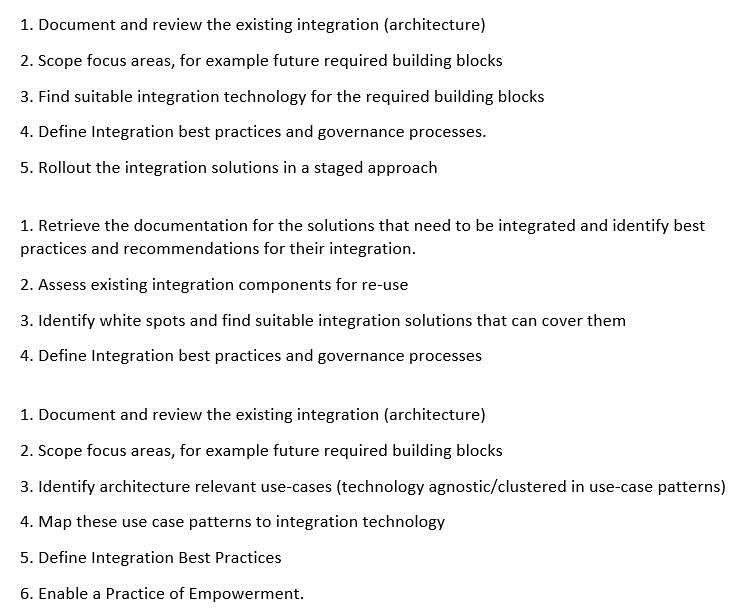
- A. 1.Document and review the existing integration (architecture)/2. Scope focus areas, for example future required building blocks/3. Find suitable integration technology for the required building blocks /4. Define Integration best practices and governance processes./5. Rollout the integration solutions in a staged approach
- B. 1.Retrieve the documentation for the solutions that need to be integrated and identify best practices and recommendations for their integration./2. Assess existing integration components for re-use./3. Identify white spots and find suitable integration solutions that can cover them./4. Define Integration best practices and governance processes.
- C. 1.Document and review the existing integration (architecture)./2. Scope focus areas, for example future required building blocks/3. Identify architecture relevant use-cases (technology agnostic/clustered in use-case patterns)/4. Map these use case patterns to integration technology./5. Define Integration Best Practices./6. Enable a Practice of Empowerment.
Answer:
C
Explanation:
The best answer for the integration approach to take for this solution is C. According to the SAP
Integration Solution Advisory Methodology (ISA-M), which is a methodology offered by SAP that
helps enterprise architects define an integration strategy for their organizations and derive related
integration guidelines, the recommended approach for identifying an integration solution and
strategy is:
Document and review the existing integration (architecture). This step involves documenting and
analyzing the current state of the integration landscape, including the integration scenarios,
technologies, patterns, standards, and governance processes. The goal is to understand the strengths
and weaknesses of the existing integration (architecture) and identify the gaps and improvement
areas.
Scope focus areas, for example future required building blocks. This step involves defining and
prioritizing the focus areas for the integration project, such as new or changed business
requirements, integration scenarios, or technologies. The focus areas are derived from the gaps and
improvement areas identified in the previous step, as well as from the business goals and drivers of
the organization. The focus areas are also mapped to future required building blocks, which are
logical components that represent the desired capabilities or functionalities of the integration
solution.
Identify architecture relevant use-cases (technology agnostic/clustered in use-case patterns). This
step involves identifying and describing the use-cases that are relevant for the integration project,
such as process integration, data integration, user integration, or thing integration. The use-cases are
technology agnostic, meaning that they do not specify any particular technology or service for
implementation. The use-cases are also clustered in use-case patterns, which are generic templates
that capture the common characteristics and requirements of similar use-cases.
Map these use case patterns to integration technology. This step involves mapping the use-case
patterns to suitable integration technologies or services that can implement them. The mapping is
based on a set of criteria and decision tables that consider various aspects of the use-case patterns,
such as complexity, performance, security, or scalability. The mapping also takes into account the
existing or planned integration technologies or services in the organization’s landscape.
Define Integration Best Practices. This step involves defining and documenting the best practices and
guidelines for designing, developing, testing, deploying, monitoring, and governing the integration
solutions. The best practices and guidelines are based on SAP’s recommendations and industry
standards, as well as on the organization’s specific needs and preferences. The best practices and
guidelines also cover various aspects of the integration project, such as naming conventions, error
handling, logging, tracing, or versioning.
Enable a Practice of Empowerment. This step involves enabling and empowering the different roles
and personas involved in the integration project, such as integration architects, developers, testers,
operators, or business users. The goal is to foster a culture of collaboration and innovation among
the stakeholders, and to provide them with the necessary skills, tools, and resources to execute their
tasks effectively and efficiently.
The other options (A and B) are not correct for the integration approach to take for this solution,
because they either skip or misrepresent some of the steps in the SAP Integration Solution Advisory
Methodology (ISA-M). For example:
Option A is not correct because it does not include identifying architecture relevant use-cases
(technology agnostic/clustered in use-case patterns), which is a key step to define and categorize the
integration requirements in a generic way. It also does not include enabling a practice of
empowerment, which is a key step to ensure the success and sustainability of the integration project.
Option B is not correct because it does not include documenting and reviewing the existing
integration (architecture), which is a key step to understand the current state of the integration
landscape and identify the gaps and improvement areas. It also does not include scoping focus areas
or mapping use case patterns to integration technology, which are key steps to define and prioritize
the future state of the integration solution.
For more information on the SAP Integration Solution Advisory Methodology (ISA-M) and its steps,
you can refer to
SAP Integration Solution Advisory Methodology: Template version 4.0 available now
| SAP Blogs
or
Integration Solution Advisory Methodology (ISA-M): Define Integration Guidelines for
Your Organization | SAP Blogs
.
Question 6
Green Elk & Company is the world's leading manufacturer of agricultural and forestry machinery. The
former company slogan "Elk always runs" has recently been changed to "Elk feeds the world" One of
Green Elk's strategic goals is to increase its revenue in the emerging markets of China, India and
other parts of Asia by 80 % within three years. This requires a new business model that caters to
significantly smaller farms with limited budgets The CIO asks you, the Chief Enterprise Architect, to
present an architecture vision to address the aforementioned business challenge. According to the
SAP Enterprise Architecture Framework, what is the best approach?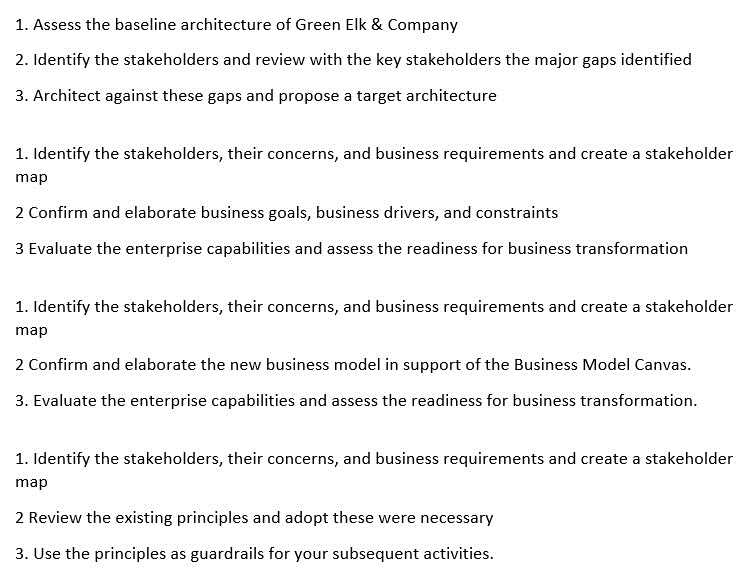
- A. 1. Assess the baseline architecture of Green Elk & Company/2. Identify the stakeholders and review with the key stakeholders the major gaps identified/3. Architect against these gaps and propose a target architecture.
- B. 1. Identify the stakeholders, their concerns, and business requirements and create a stakeholder map/2 Confirm and elaborate business goals, business drivers, and constraints/3 Evaluate the enterprise capabilities and assess the readiness for business transformation
- C. 1. Identify the stakeholders, their concerns, and business requirements and create a stakeholder map/2 Confirm and elaborate the new business model in support of the Business Model Canvas./3. Evaluate the enterprise capabilities and assess the readiness for business transformation.
- D. 1. Identify the stakeholders, their concerns, and business requirements and create a stakeholder map.2 Review the existing principles and adopt these were necessary3. Use the principles as guardrails for your subsequent activities.
Answer:
B
Explanation:
According to the SAP Enterprise Architecture Framework, the best approach to addressing a
business challenge through an architecture vision would be:
Identify the stakeholders, their concerns, and business requirements to create a comprehensive
stakeholder map. This step is crucial to ensure that the architecture will address the needs of all
parties involved.
Confirm and elaborate on business goals, business drivers, and constraints to clearly understand the
objectives and limitations that the architecture must operate within.
Evaluate the enterprise capabilities and assess the readiness for business transformation to
determine if the organization has the necessary resources, processes, and technology to support the
new business model and achieve the strategic goals.
This method ensures that the architecture vision is aligned with the business strategy, that
stakeholder needs are adequately addressed, and that the company is prepared for the changes that
will come with the new business model.
Reference = These steps are foundational to the SAP Enterprise Architecture Framework process and
are detailed in SAP's EA documentation, particularly in the sections concerning the development of
an architecture vision aligned with business strategy.
Question 7
Green Elk & Company is the world's leading manufacturer of agricultural and forestry machinery. The
former company slogan "Elk always runs has recently been changed to "Elk feeds the world" One of
Green Elk's strategic goals is to increase its revenue in the emerging markets of China, India, and
other parts of Asia by 80 % within three years. This requires a new business model that caters to
significantly smaller farms with limited budgets. You are the Chief Enterprise Architect and the CIO
asked you to conduct interviews with the key stakeholders of Green Elk to assess the business
strategy. You are planning to interview the owner of the business unit of finished goods. Which of the
following sets of questions would you ask?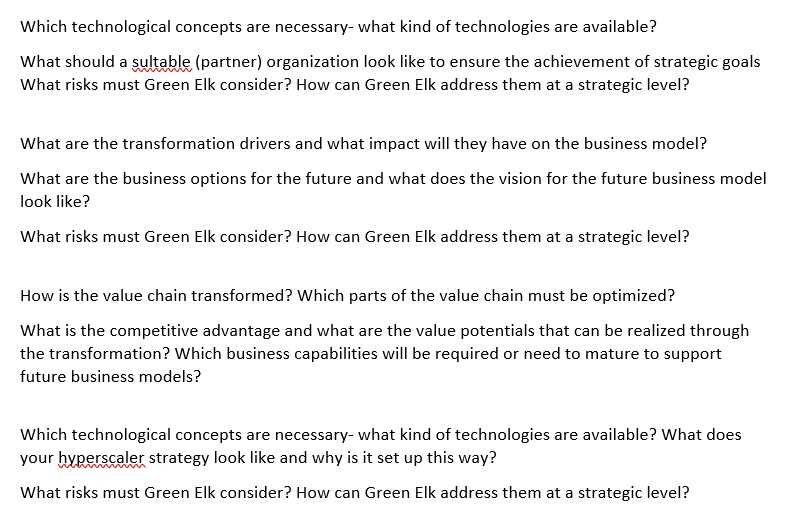
- A. Which technological concepts are necessary- what kind of technologies are available? What should a sultable (partner) organization look like to ensure the achievement of strategic goals What risks must Green Elk consider? How can Green Elk address them at a strategic level?
- B. What are the transformation drivers and what impact will they have on the business model?What are the business options for the future and what does the vision for the future business model look like?What risks must Green Elk consider? How can Green Elk address them at a strategic level?
- C. How is the value chain transformed? Which parts of the value chain must be optimized?What is the competitive advantage and what are the value potentials that can be realized through the transformation? Which business capabilities will be required or need to mature to support future business models?
- D. Which technological concepts are necessary- what kind of technologies are available? What does your hyperscaler strategy look like and why is it set up this way? What risks must Green Elk consider? How can Green Elk address them at a strategic level?
Answer:
C
Explanation:
In the context of Green Elk & Company’s strategic goal to expand in emerging markets, the most
pertinent set of questions to ask the owner of the business unit of finished goods would focus on the
transformation of the value chain and the competitive advantages that can be leveraged. Therefore,
the best set of questions is represented by option C:
How is the value chain transformed? This question aims to understand the changes required in the
current value chain to support the new business model targeting smaller farms with limited budgets.
It’s essential to identify which processes and interactions need to be adapted or redefined to meet
the needs of the emerging markets.
Which parts of the value chain must be optimized? Optimization efforts should be directed towards
the most impactful areas of the value chain that can drive efficiency, reduce costs, and improve
service delivery in the context of the new markets.
What is the competitive advantage and what are the value potentials that can be realized through
the transformation? Understanding the unique strengths of Green Elk & Company and how they can
be harnessed to create value in the new business environment is crucial for the success of the
expansion strategy.
Which business capabilities will be required or need to mature to support future business
models? The company must assess its current capabilities and determine which ones need to be
developed or enhanced to support the strategic goals effectively.
These questions are designed to elicit information that will help in crafting a business strategy that is
aligned with the company’s vision of feeding the world and achieving significant revenue growth in
the targeted emerging markets.
Reference:
SAP. (n.d.). SAP Enterprise Architecture Framework. SAP Community.
The Open Group. (2018). TOGAF® Version 9.2: Enterprise Architecture Framework.
Porter, M.E. (1985). Competitive Advantage: Creating and Sustaining Superior Performance. Free
Press.
Question 8
Green Elk & Company is the world's leading manufacturer of agricultural and forestry machinery. The
former company slogan "Elk always runs" has recently been changed to "Elk feeds the world". One of
Green Elk's strategic goals is to increase its revenue in the emerging markets of China, India, and
other parts of Asia by 80 % within three years. This requires a new business model that caters to
significantly smaller farms with limited budgets. You are the Chief Enterprise Architect and the CIO
asks you to assess the now business model for smaller farms with smaller budgets. By applying the
Sustainable Business Model Canvas, which sequence of steps is best practice?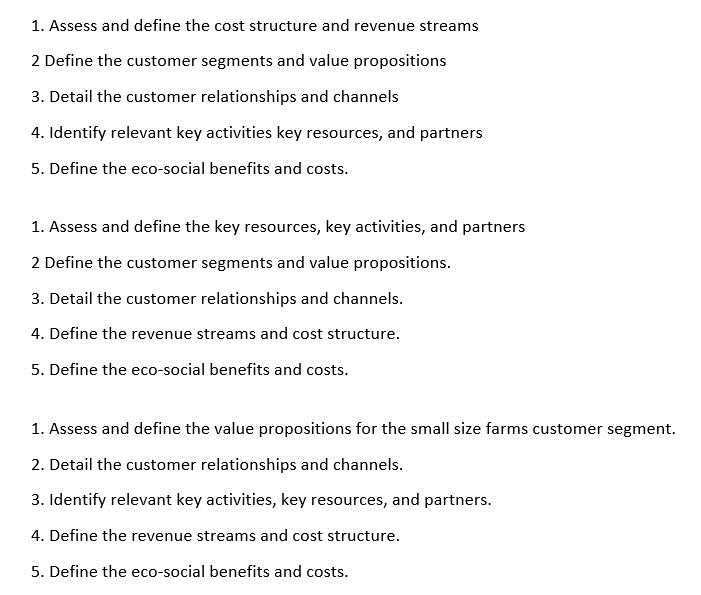
- A. 1. Assess and define the cost structure and revenue streams/2 Define the customer segments and value propositions/3. Detail the customer relationships and channels/4. Identify relevant key activities key resources, and partners/5. Define the eco-social benefits and costs.
- B. 1. Assess and define the key resources, key activities, and partners/2 Define the customer segments and value propositions. /3. Detail the customer relationships and channels. /4. Define the revenue streams and cost structure. /5. Define the eco-social benefits and costs.
- C. 1. Assess and define the value propositions for the small size farms customer segment. /2. Detail the customer relationships and channels. /3. Identify relevant key activities, key resources, and partners. /4. Define the revenue streams and cost structure. /5. Define the eco-social benefits and costs.
Answer:
C
Explanation:
The Sustainable Business Model Canvas approach for assessing new business models, especially for
smaller farms with smaller budgets, starts with understanding the unique value propositions tailored
to the needs of small-size farm owners. This is crucial in creating offerings that resonate well with the
target market's requirements and constraints. Following this, detailing customer relationships and
channels becomes essential in establishing and maintaining a strong connection with the market
segment, ensuring the delivery mechanism aligns with their preferences and capabilities. The next
step involves identifying the key activities, resources, and partnerships necessary to deliver on the
value proposition effectively, which is critical for operational execution and sustainability.
Subsequently, defining the revenue streams and cost structure is paramount to ensure financial
viability and strategic pricing that aligns with the target market's budgetary limitations. Lastly,
delineating the eco-social benefits and costs integrates the broader impact of the business model,
aligning with sustainable and ethical business practices, which is increasingly important for modern
enterprises.
Reference = This sequence is aligned with the methodologies proposed by Alexander Osterwalder in
the context of business model development and specifically tailored by SAP for digital business
modeling and value engineering within the SAP ecosystem. This approach encompasses strategies
for optimizing business processes through value discovery workshops and the application of value
management processes across various lifecycle phases (Source: SAP Enterprise Support Services
documentation, Digital Business Modelling guidelines, and SAP Value Engineering methodologies).
Question 9
Which of the following lists of SAP Enterprise Architecture artifacts support making informed Target
Application Architecture decisions that are aligned with the strategic direction of a company?
- A. Stakeholder Map/Business Strategy Map/Solution Strategy/Architecture Roadmap
- B. Principles Standards, Guidelines/Solution Context/Baseline Business and Solution Architecture
- C. Solution Context/Solution Concept/Stakeholder Map/Baseline Business and Solution Architecture
Answer:
A
Explanation:
To make informed decisions about the Target Application Architecture that are aligned with the
strategic direction of a company, certain artifacts are necessary to ensure that there is a clear
connection between the stakeholder needs, business strategy, and the architectural vision. Option A
includes a Stakeholder Map, which identifies the key players and their interests; a Business Strategy
Map, which outlines the strategic objectives; a Solution Strategy, which details the approach to
achieve the objectives through solutions; and an Architecture Roadmap, which lays out the plan to
move from the current to the future state. These artifacts together provide a comprehensive view
that guides the Target Application Architecture towards aligning with the company's strategic
direction.
Reference:
Enterprise Architecture frameworks and methodologies that outline the use of strategic artifacts in
architecture development.
Guidelines on creating architecture roadmaps that align with business strategies.
Question 10
Which of the following set of artifacts does SAP provide as part of the SAP Reference Solution
Architecture content?
- A. Solution Value Flow Diagram/Solution Process Flow Diagram/Solution Component Diagram/Solution Data Flow Diagram.
- B. Solution Context Diagram/Solution Component Diagram/Solution Application Use-Case Diagram/Solution Value Flow Diagram.
- C. Solution Value Flow Diagram/Solution Process Flow Diagram/Solution Component Diagram.
Answer:
B
Explanation:
SAP provides several artifacts as part of the SAP Reference Solution Architecture content to guide
and streamline solution design and implementation. The artifacts provided are aimed at delivering
comprehensive architectural documentation to cover various aspects of the solution architecture.
Option B includes the Solution Context Diagram, which provides a high-level view of the system's
environment and boundaries. The Solution Component Diagram gives an overview of the
components and their interactions within the system. The Solution Application Use-Case Diagram
describes how different users will interact with the application. The Solution Value Flow Diagram
illustrates the value that flows through the system and between stakeholders.
Reference:
SAP documentation on Solution Architecture best practices.
Resources detailing the SAP Reference Architecture framework.
Question 11
Which artifact from the SAP Reference Solution Architecture shows which data objects are exchanged
between SAP application components in a given end-to-end scenario?
- A. SAP Data Object Diagram, which is available from SAP API Business Accelerator Hub (api.sap.com)
- B. SAP Data Flow Diagram, which is available from SAP API Business Accelerator Hub (api sap.com)
- C. SAP Data Component Diagram, which is available in SAP Signavio Process Explorer
Answer:
B
Explanation:
The SAP Data Flow Diagram (DFD) is an artifact from the SAP Reference Solution Architecture that
shows which data objects are exchanged between SAP application components in a given end-to-end
scenario. The DFD uses a graphical representation to show the flow of data between different
components of a system.
The SAP Data Object Diagram (DOD) is also an artifact from the SAP Reference Solution Architecture,
but it does not show the flow of data between different components. The DOD shows the structure
of data objects, including their attributes and relationships.
The SAP Data Component Diagram (DCD) is an artifact from SAP Signavio Process Explorer, which is a
tool for modeling business processes. The DCD shows the different components of a system,
including their relationships.
Therefore, the correct answer is option B.
Here is a table that summarizes the different artifacts and their purposes:
According to the SAP Reference Architecture Content: An Overview – Part 2 , the SAP Data Flow
Diagram is an artifact that shows the flow of data through the SAP solution, from the source to the
destination. It also shows which data objects are exchanged between the different components and
services of the SAP solution, such as master data, transactional data, analytical data, or configuration
data. The SAP Data Flow Diagram can help you to understand and communicate how data is created,
transformed, and consumed in a SAP solution, and to identify and optimize the data integration
points and dependencies.
The other options (A and C) are not correct for the artifact from the SAP Reference Solution
Architecture that shows which data objects are exchanged between SAP application components in a
given end-to-end scenario, because they either do not exist or do not show the data flow. For
example:
Option A is not correct because there is no such artifact as SAP Data Object Diagram in the SAP
Reference Solution Architecture content. The SAP API Business Accelerator Hub (api.sap.com) is a
platform that provides access to SAP APIs, events, and related resources, but it does not provide any
diagrams that show the data objects exchanged between SAP application components.
Option C is not correct because the SAP Data Component Diagram is not an artifact that shows the
data flow, but rather an artifact that shows the main components and services that constitute the
target application architecture, as well as their relationships and interactions. The SAP Data
Component Diagram does not show which data objects are exchanged between the different
components and services of the SAP solution. The SAP Signavio Process Explorer is a tool that helps
you to model, analyze, and optimize business processes, but it does not provide any diagrams that
show the data flow.
Question 12
Green Elk & Company is the world's leading manufacturer of agricultural and forestry machinery. The
former company slogan "Elk always runs has recently been changed to Elk feeds the world". One of
Green Elk's strategic goals is to increase its revenue in the emerging markets of China, India, and
other parts of Asia by 80 % within three years. This requires a new business model that caters to
significantly smaller farms with limited budgets. You are the Chief Enterprise Architect and the CIO
asks you to assess the new business model for smaller farms with smaller budgets. Given the
principle and statement, which of the following combinations of rationale and implication do you
consider well-defined?
A)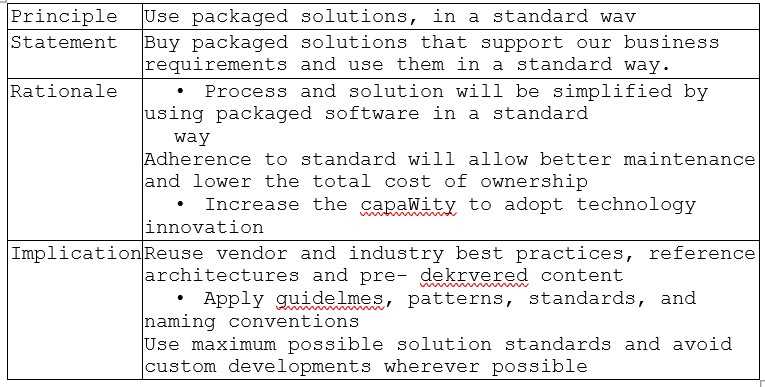
B)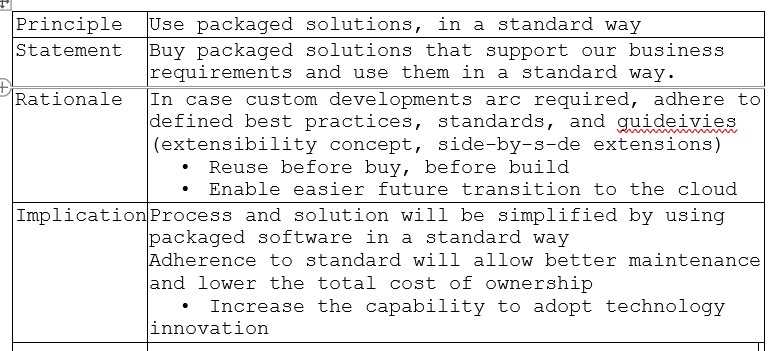
C)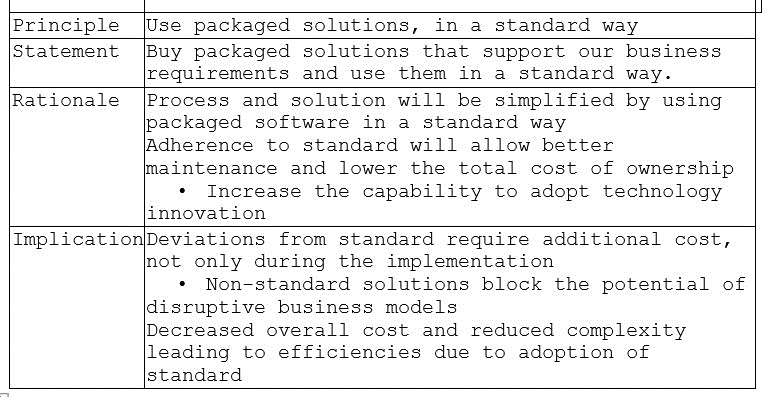
D)
- A. Option A
- B. Option B
- C. Option C
- D. Option D
Answer:
D
Explanation:
The rationale and implication in this combination are well-defined because they both support the
principle of using packaged solutions in a standard way. The rationale explains the benefits of using
packaged solutions, while the implication outlines the steps that need to be taken to ensure that
packaged solutions are used in a standard way.
According to the SAP Enterprise Architecture Framework, which is a methodology and toolset by the
German multinational software company SAP that helps enterprise architects define and implement
an architecture strategy for their organizations, a principle is a general rule or guideline that
expresses a fundamental value or belief, and that guides the design and implementation of the
architecture. A principle consists of four elements: a name, a statement, a rationale, and an
implication. The name is a short and memorable label that summarizes the principle. The statement
is a concise and precise description of the principle. The rationale is an explanation of why the
principle is important and beneficial for the organization. The implication is a description of the
consequences or impacts of applying or not applying the principle.
The principle in option D is:
Name: Use packaged solutions, in a standard way.
Statement: Buy packaged solutions that support our business requirements and use them in a
standard way.
Rationale: Process and solution will be simplified by using packaged software in a standard way.
Adherence to standard will allow better maintenance and lower the total cost of ownership. Increase
the capability to adopt technology innovation.
Implication: In case custom developments are required, adhere to defined best practices, standards,
and guidelines (extensibility concept, side-by-side extensions). Reuse before buy, before build.
Enable easier transition to the cloud in the future.
This combination of rationale and implication is well-defined because it clearly and logically explains
the benefits and consequences of following or not following the principle. The rationale shows how
using packaged solutions in a standard way can simplify the process and solution, reduce the cost and
effort of maintenance, and increase the ability to adopt new technologies. The implication shows
how custom developments should be minimized and standardized, how reuse should be preferred
over buying or building new solutions, and how cloud readiness should be considered for future
scalability.
The other options (A, B, C) are not correct for the combination of rationale and implication that is
well-defined because they either mix up or confuse some of the elements of the principle. For
example:
Option A is not correct because it mixes up the rationale and implication elements. The first sentence
of the rationale (“Process and solution will be simplified by using packaged software in a standard
way”) is actually an implication of following the principle, not a reason for following it. The first
sentence of the implication (“Reuse vendor and industry best practices, reference architectures and
pre-delivered content”) is actually a rationale for following the principle, not a consequence of
following it.
Option B is not correct because it confuses the rationale and implication elements. The first sentence
of the rationale (“In case custom developments are required, adhere to defined best practices,
standards, and guidelines (extensibility concept, side-by-side extensions)”) is actually an implication
of following the principle, not a reason for following it. The first sentence of the implication (“Process
and solution will be simplified by using packaged software in a standard way”) is actually a rationale
for following the principle, not a consequence of following it.
Option C is not correct because it confuses the rationale and implication elements. The second
sentence of the rationale (“Adherence to standard will allow better maintenance and lower the total
cost of ownership”) is actually an implication of following the principle, not a reason for following it.
The second sentence of the implication (“Reuse before buy, before build”) is actually a rationale for
following the principle, not a consequence of following it.
Question 13
As part of the mapping of a Business Architecture to the Solution Architecture, an Environment &
Location Diagram must be developed in the Technology Architecture phase. In this context,
numerous architecture decisions have to be made. Among other things, you must check which SAP
BTP services and which SAP SaaS solutions are available as part of the Solution Architecture in which
data center of the desired hyperscaler. How do you go about this validation?
- A. I use the SAP Business Accelerator Hub (api.sap.com) because it provides all the required information regarding SAP BTP service and SAP SaaS solution availability for each hyperscaler, in a central location.
- B. I use the SAP Discovery Center to check which of the selected SAP BTP services are offered by which hyperscaler. With help from the SAP Trust Center, I check in which data center the involved SAP SaaS solutions are available.
- C. I use the SAP Discovery Center to check in which data centers the respective SAP BTP services and the SAP SaaS solutions are available.
Answer:
B
Explanation:
According to the SAP Discovery Center 1
and the SAP Trust Center
, the steps involved in this
validation are:
Use the SAP Discovery Center to check which of the selected SAP BTP services are offered by which
hyperscaler. The SAP Discovery Center is a platform that provides access to SAP BTP services, events,
and related resources, and helps you to implement your use cases on SAP BTP with step-by-step
guidance and support from topic experts and SAP Community. In the Service Catalog section of the
SAP Discovery Center, you can browse and filter the available SAP BTP services by category, region,
or hyperscaler. You can also compare the features and pricing of different services, and learn how to
use them in your projects.
Use the SAP Trust Center to check in which data center the involved SAP SaaS solutions are available.
The SAP Trust Center is a platform that provides information on cloud performance, security, privacy,
and compliance. In the Certification and Compliance section of the SAP Trust Center, you can find
certificates, reports, and attestations that show how SAP meets various industry standards and
regulatory requirements. You can also filter the documents by solution, region, or hyperscaler, and
download them for your reference.
The other options (A and C) are not correct for how to validate the availability of SAP BTP services
and SAP SaaS solutions in the desired hyperscaler’s data center, because they either do not exist or
do not provide the required information. For example:
Option A is not correct because there is no such platform as SAP Business Accelerator Hub
(api.sap.com) that provides all the required information regarding SAP BTP service and SAP SaaS
solution availability for each hyperscaler. The correct name of the platform is SAP API Business Hub
(api.sap.com), which is a platform that provides access to SAP APIs, events, and related resources,
but it does not provide any information on the availability of SAP BTP services or SAP SaaS solutions
for each hyperscaler or data center.
Option C is not correct because the SAP Discovery Center does not provide any information on the
availability of SAP SaaS solutions for each hyperscaler or data center. The SAP Discovery Center only
provides information on the availability of SAP BTP services for each hyperscaler or region, but not
for specific data centers. To check the availability of SAP SaaS solutions for each data center, you need
to use the SAP Trust Center instead.
Question 14
Why is it useful to create Transition Architectures in the Application Architecture domain?
- A. They structure complex application architectures that require multiple changes to existing independent applications and/or the rollout of new applications. Considered applications/solutions do NOT depend on the existence of others.
- B. They reduce the total number of solution components in the target state of complex application architectures that require multiple changes of existing applications and/or rollout of new applications. All applications/solutions do NOT depend on the existence of others.
- C. They structure complex application architectures that require multiple changes of existing interdependent applications and/or the rollout of new applications. Some applications/solutions depend on the existence of others.
Answer:
C
Explanation:
According to the SAP Enterprise Architecture Framework, which is a methodology and toolset by the
German multinational software company SAP that helps enterprise architects define and implement
an architecture strategy for their organizations, Transition Architectures are intermediate states
between the Baseline Architecture (the current situation) and the Target Architecture (the desired
future state). Transition Architectures describe how to move from one state to another in a feasible
and manageable way, taking into account the constraints and dependencies of the project. Transition
Architectures are useful for structuring complex application architectures that require multiple
changes of existing interdependent applications and/or the rollout of new applications. Some
applications/solutions depend on the existence of others, meaning that they cannot be implemented
or operated without the presence or functionality of other applications/solutions. For example, a
new application that relies on data from an existing application, or an existing application that needs
to be integrated with a new application. By creating Transition Architectures, enterprise architects
can:
Define and prioritize the sequence and timing of the changes and rollouts that are needed to achieve
the Target Architecture.
Identify and mitigate the risks and issues that might arise during the transition process, such as
technical, operational, or organizational challenges.
Communicate and align with the stakeholders and sponsors of the project, such as business owners,
users, developers, vendors, etc.
Monitor and control the progress and performance of the project, and ensure that it meets the
requirements and expectations of the project.
Transition Architectures are useful in the Application Architecture domain because they can help to
structure complex application architectures that require multiple changes of existing interdependent
applications and/or the rollout of new applications.
In some cases, it may be possible to make changes to existing applications independently of each
other. However, in many cases, changes to one application will require changes to other applications.
This is because applications often depend on each other for data or functionality.
Transition Architectures can help to identify these dependencies and to plan the changes to the
applications in a way that minimizes the impact on the business. They can also help to ensure that
the changes are made in a consistent and orderly fashion.
The following are some of the benefits of using Transition Architectures in the Application
Architecture domain:
They can help to improve the visibility of complex application architectures.
They can help to identify dependencies between applications.
They can help to plan the changes to applications in a way that minimizes the impact on the
business.
They can help to ensure that the changes are made in a consistent and orderly fashion.
Therefore, Transition Architectures can be a valuable tool for managing complex application
architectures.
Question 15
Green Elk & Company is the world's leading manufacturer of agricultural and forestry machinery. The
former company slogan "Elk always runs has recently been changed to "Elk feeds the world". One of
Green Elk's strategic goals is to increase its revenue in the emerging markets of China, India, and
other parts of Asia by 80% within three years. This requires a new business model that caters to
significantly smaller farms with limited budgets. The CIO asks you, the Chief Enterprise Architect, to
present an Architecture Roadmap that addresses the business challenge. According to the SAP
Enterprise Architecture Framework, what is the best answer?
- A. Create a work breakdown structure to identify milestones, key deliverables and resources to outline the planned transformation.
- B. Reuse the artifacts of previous phases as input for creating roadmaps. Focus on the Target Architecture and define an application architecture roadmap.
- C. Reuse the artifacts of previous phases as input for creating roadmaps. Focus on the Business Strategy Map with business capabilities and initiatives and define a business architecture roadmap
- D. Reuse the artifacts of previous phases as input for creating roadmaps. Start with a roadmap construction table, by defining initiatives and business outcomes, and detailing the business capabilities and solutions, to create two versions of a roadmap (outcome-based and application- specific)
Answer:
D
Explanation:
The SAP Enterprise Architecture Framework (EAF) defines an Architecture Roadmap as a "high-level
plan that describes the sequence of activities and deliverables required to achieve the target
architecture." The roadmap should be based on the artifacts of the previous phases of the EAF, such
as the Business Strategy Map, the Solution Concept, and the Baseline Business and Solution
Architecture.
The first step in creating an Architecture Roadmap is to define the initiatives that will be needed to
achieve the target architecture. These initiatives should be aligned with the business outcomes that
the organization is trying to achieve.
The next step is to detail the business capabilities and solutions that will be needed to support the
initiatives. This will help to ensure that the roadmap is realistic and achievable.
Finally, the roadmap should be created in two versions: an outcome-based roadmap and an
application-specific roadmap. The outcome-based roadmap will show how the initiatives will achieve
the business outcomes. The application-specific roadmap will show how the solutions will be
implemented.
By following these steps, you can create an Architecture Roadmap that will help you to achieve your
organization's strategic goals.
Here are some of the benefits of creating an Architecture Roadmap:
It can help you to visualize the sequence of activities and deliverables required to achieve your goals.
It can help you to identify dependencies between activities and deliverables.
It can help you to track progress and to make adjustments as needed.
It can help you to communicate your plans to stakeholders.
Therefore, an Architecture Roadmap can be a valuable tool for managing complex transformations.
According to the SAP Enterprise Architecture Framework, which is a methodology and toolset by the
German multinational software company SAP that helps enterprise architects define and implement
an architecture strategy for their organizations, the steps involved in creating an Architecture
Roadmap are:
Reuse the artifacts of previous phases as input for creating roadmaps. The previous phases of the
architecture development cycle are: architecture vision, business architecture, information systems
architecture, and technology architecture. The artifacts of these phases provide the information and
guidance for defining the scope, objectives, stakeholders, requirements, constraints, and solutions of
the architecture project. Some of the artifacts that can be reused for creating roadmaps are:
stakeholder map, business strategy map, solution strategy, solution context diagram, solution
component diagram, solution application use-case diagram, solution value flow diagram, etc.
Start with a roadmap construction table, by defining initiatives and business outcomes, and detailing
the business capabilities and solutions. A roadmap construction table is a tool that helps to structure
and organize the information and elements that are needed to create a roadmap. It consists of four
columns: initiatives, business outcomes, business capabilities, and solutions. Initiatives are the
strategic actions or projects that are planned to achieve the business goals and drivers. Business
outcomes are the measurable results or benefits that are expected from implementing the
initiatives. Business capabilities are the skills, resources, and competencies that are required or need
to mature to support the initiatives and outcomes. Solutions are the products or services that are
used or delivered to enable the capabilities and outcomes.
Create two versions of a roadmap (outcome-based and application-specific). A roadmap is a visual
representation of the transition architectures that will move the organization from its current state
(baseline architecture) to its desired future state (target architecture). A roadmap shows the
sequence and timing of the transition architectures, as well as the deliverables, resources, and risks
associated with each transition architecture. There are two types of roadmaps that can be created:
outcome-based and application-specific. An outcome-based roadmap focuses on the business
outcomes that are achieved by implementing the transition architectures. An application-specific
roadmap focuses on the solutions or applications that are implemented or changed by the transition
architectures.
The other options (A, B, C) are not correct for how to present an Architecture Roadmap that
addresses the business challenge because they either skip or misrepresent some of the steps in
creating an Architecture Roadmap. For example:
Option A is not correct because it does not include reusing the artifacts of previous phases as input
for creating roadmaps, which is an important step to ensure alignment and consistency with the
architecture project. It also suggests creating a work breakdown structure instead of a roadmap
construction table, which is not a tool in this framework.
Option B is not correct because it does not include creating two versions of a roadmap (outcome-
based and application-specific), which is an important step to provide different perspectives and
levels of detail for the roadmap. It also suggests focusing on the target architecture instead of the
transition architectures, which is not a logical approach since the latter determine how to achieve
the former.
Option C is not correct because it does not include starting with a roadmap construction table, which
is an important step to structure and organize the information and elements that are needed to
create a roadmap. It also suggests focusing on the business strategy map instead of the initiatives
and outcomes, which is not a sufficient level of detail for creating a roadmap.